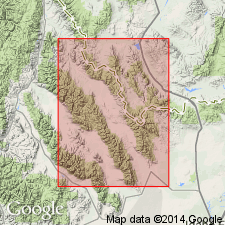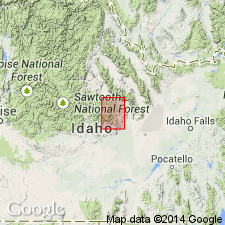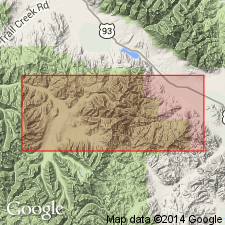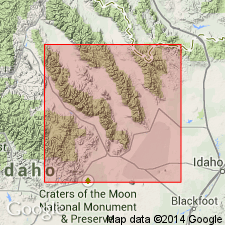
- Usage in publication:
-
- White Knob Limestone*
- Modifications:
-
- Named
- Dominant lithology:
-
- Limestone
- AAPG geologic province:
-
- Idaho Mountains province
Summary:
Name proposed for limestone that has been incorrectly assigned to the Brazer Limestone in south-central ID. Term Brazer as applied in ID to limestones that range from Early Mississippian to Early Permian is not consistent with Brazer at its type. Brazer will no longer be used in south-central ID. The replacement term White Knob Limestone is named for exposures on ridge above Cabin Creek in the White Knob Mountains, Custer Co, ID in the Idaho Mountains province; these exposures [inferred] to be the type locality. Is more than 7,300 ft thick at type; may be 10,000+ ft thick elsewhere. Consists of limestone with chert as nodules and laminae, and minor non-persistent silty, sandy, and conglomeratic beds. Overlies and intertongues with Milligen Formation. Intertongues with the newly named Copper Basin Formation. No younger pre-Tertiary strata identified in south-central ID. Has fossils that range from Early Mississippian to Early Permian.
Source: GNU records (USGS DDS-6; Denver GNULEX).

- Usage in publication:
-
- White Knob Group*
- Modifications:
-
- Revised
- Areal extent
- AAPG geologic province:
-
- Snake River basin
Summary:
Raised in stratigraphic rank from White Knob Formation to White Knob Group and geographically extended into the southern Lemhi Range, ID, Snake River basin, where it is divided into four newly named formations--(ascending) the Middle Canyon, Scott Peak, South Creek, and Surrett Canyon Formations. White Knob overlies Milligen Formation and underlies an unnamed Pennsylvanian and Permian quartzite and carbonate sequence. Columnar sections. Mississippian age.
Source: GNU records (USGS DDS-6; Denver GNULEX).

- Usage in publication:
-
- White Knob Limestone*
- Modifications:
-
- Overview
- AAPG geologic province:
-
- Idaho Mountains province
- Snake River basin
Summary:
Mapped; exposed in eastern and north-central part of quad, Blaine and Butte Cos, ID, Snake River basin and Custer Co, ID, Idaho Mountains province. Consists of limestone with chert in layers and nodules; interbeds of conglomerate and sandstone in middle part of unit. No thickness given. Unconformably underlies Challis Volcanics; overlies Milligen Formation; intertongues with part of Copper Basin Formation (age modified). Early Mississippian to Early Permian age.
Source: GNU records (USGS DDS-6; Denver GNULEX).

- Usage in publication:
-
- White Knob Limestone*
- Modifications:
-
- Overview
- Biostratigraphic dating
- Age modified
- AAPG geologic province:
-
- Idaho Mountains province
Summary:
Type locality reexamined (Custer Co, ID, Idaho Mountains province). White Knob at type is 5,500 ft thick, of Visean and Namurian age, and divisible into five parts. The lower 1,150 ft is sparsely fossiliferous (forams) recrystallized micrite and spiculite, non-turbulent shallow water deposit and similar to Middle Canyon and lower Scott Peak Formations of Lemhi Range to east. The lower middle 1,300 ft are recrystallized, medium- to coarse-grained, bioclastic limestone and reefoid accumulations indicative of open circulation shallow marine carbonate shelf deposit with Zone 16, early Chester or early late late Visean forams, and equivalent to upper Scott Peak Formation. The upper middle 1,600 ft are interbedded conglomerate, sandstone and limestone of beach gravel to shallow water turbulent normal marine origin with forams of Zone 16S, equivalent to uppermost Scott Peak and South Creek Formations. The lower upper 1,150 ft of interbedded limestone, conglomerate, and sandstone with early Namurian, Chesterian Zone 17 forams is equivalent to basal Surrett Canyon Formation and same origin as Zone 16S. The upper 300 ft is limestone with abundant forams of early Namurian, Chester Zone 18 age and is equivalent to part of Surrett Canyon. No equivalent of Zone 19 or upper Surrett Canyon present at type. Overlies Milligen Formation. Unconformably underlies Challis Volcanics. Columnar section. Lists of forams.
Source: GNU records (USGS DDS-6; Denver GNULEX).

- Usage in publication:
-
- White Knob Limestone*
- Modifications:
-
- Overview
- AAPG geologic province:
-
- Idaho Mountains province
Summary:
Pg. 2, 5, 11, figs. 1, 4. White Knob Limestone. In type area, in White Knob Mountains, Custer County, south-central Idaho, gradationally underlies thin calcareous sandstone or sandy limestone beds considered to be correlative with the Bluebird Mountain Formation (new). [Elsewhere in report, beds are called Bluebird Mountain Formation.] Correlates with Scott Peak, South Creek, Surrett Canyon, Arco Hills (new), and Big Snowy Formations. Age is Late Mississippian (Chesterian); Mamet microfossil zones 16 to 19 (Mamet and Skipp, 1970).
Source: Publication.

- Usage in publication:
-
- White Knob Limestone*
- Modifications:
-
- Revised
- Overview
- AAPG geologic province:
-
- Idaho Mountains province
Summary:
Contacts revised in White Knob Mountains, Custer Co, ID, Idaho Mountains province. Overlies McGowan Creek Formation; underlies Bluebird Mountain Formation. [In this report, in White Knob Mountains, Milligen and Copper Basin Formations of Nelson and Ross (1969) are replaced by McGowan Creek; Nelson and Ross mapped Challis Volcanics as the unit overlying White Knob Limestone.] Cross sections; correlation chart; isopach map. Maximum thickness is 1,675 m. Lower part, consisting of fine-grained argillaceous and laminated silty spiculitic mudstone, considered to be forebank deposits. Upper part, consisting of clean wackestone, grainstone, and packstone which are interbedded in upper 840 m with lenses of conglomerate, sandstone, and minor siltstone, represents westernmost prograding Upper Mississippian carbonate bank deposits. Late Mississippian age.
Source: GNU records (USGS DDS-6; Denver GNULEX).
For more information, please contact Nancy Stamm, Geologic Names Committee Secretary.
Asterisk (*) indicates published by U.S. Geological Survey authors.
"No current usage" (†) implies that a name has been abandoned or has fallen into disuse. Former usage and, if known, replacement name given in parentheses ( ).
Slash (/) indicates name conflicts with nomenclatural guidelines (CSN, 1933; ACSN, 1961, 1970; NACSN, 1983, 2005, 2021). May be explained within brackets ([ ]).

